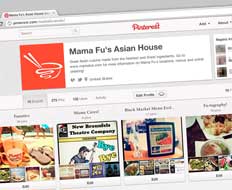By now, just about every quick-service brand and operator has figured out how critical social networking is to their business and has set about posting, tweeting, and sharing things important to their brand.
But with the growing prominence of image-based social networks like Pinterest and Instagram, restaurants might finally have tools uniquely suited to their strengths. After all, few things entice the eyes stronger than food, and a well-taken photograph of a cappuccino, cupcake, or hamburger has the power to lure customers from miles away.
Pinterest, an online pin board, and Instagram, a smartphone app that lets members filter and share photos, are leading the charge of image-based social networks. These networks are distinguishable from platforms like Twitter and Facebook, which facilitate image sharing but are essentially text-centric in function and design. (Facebook recently acquired Instagram for $1 billion, a signal that the social-networking behemoth sees image sharing as the wave of the future.)
Plenty of quick serves are already using Pinterest and Instagram, which launched in September 2011 and October 2010, respectively. Starbucks, for example, has more than 8,400 followers on Pinterest and nearly 600,000 followers on Instagram, where it shares “freshly brewed” photos and encourages users to share their photos with the hashtag #Starbucks. Red Mango cofounder Dan Kim has nearly 1,500 Pinterest followers and more than 5,300 followers on Instagram.
Restaurants that aren’t taking advantage of image-based social networks are making a mistake, says Erik Oberholtzer, chef and co-owner of Tender Greens, a fast-casual concept with seven California locations.
“Photos are more impactful in general than text,” Oberholtzer says. “That’s a long-standing reality—a picture is worth a thousand words. But it also really gives us an opportunity to create … a snapshot of the brand that really speaks to the complexity of what Tender Greens is, without getting too complex.”
With 397 followers, Tender Greens is still in the early stages of cultivating a following on Pinterest, using the platform to show what it would otherwise struggle to tell.
Pinterest users pin the images they wish to share to particular boards. Tender Greens’ 19 different boards include a “Farmers & Artisans We Support” board, with photos of the various providers the restaurant works with; a “Cooking & Eating” board, with photos of Tender Greens dishes; an “Art” board, with photos of work by local artists that the restaurant commissions and displays in its stores; and a “#TGPick Winners” board, with photos shared by customers who enter to win a Tender Greens T-shirt.
Tender Greens’ Pinterest page, Oberholtzer says, expresses the restaurant’s identity more succinctly and compellingly than several paragraphs on a Facebook or Twitter “About” page.
“To really talk about what we’re about, what we’re doing, who influences or inspires us, or who we associate ourselves with becomes a long, drawn-out document,” he says. “Pinterest affords us the opportunity to express ourselves without sounding as if it’s a packaged marketing campaign.”
As Tender Greens’ use of Pinterest shows, restaurants can use image-based social networks for more than sharing photos of their food.
“With restaurants, of course, the food is naturally visually interesting and appealing content to share with guests,” says Albert Im, marketing manager for Mama Fu’s, an Asian cuisine concept based in Austin, Texas. “But, at the same time, our guests that have already come to know and love our food are already very familiar with our dishes.”
Mama Fu’s uses both Pinterest (76 followers) and Instagram (133 followers) to share photos from the kitchen, relevant infographics, and video cooking tips (Pinterest supports video in addition to still images). The chain considers the networks as virtual counterparts to its brick-and-mortar restaurants.
“We want to be able to continue our relationship with our guests outside of the restaurant,” Im says. “And the platforms of Pinterest and Instagram are basically another area where we have guests come to visit us.”
As with all social networks, image-based platforms open up a two-way street, empowering customers as much as they empower businesses. This means a restaurant can use a service like Instagram to market its new club sandwich, while an outraged customer can use it to share a photo of the restaurant’s untidy bathroom.
Brian Zuercher is CEO of VenueSeen, which helps operators aggregate photos of their business that customers share via various social networks. While no business wants customers to share unflattering photos, he says, the pros of platforms like Instagram and Pinterest far outweigh the cons.
“I think this is more good than bad,”
Zuercher says. “First of all, their customers are most of the time creating unbelievable content in marketing for them. … So they can expose their brand [and] their products very quickly, and [the restaurants] don’t have to do anything. That’s happening for free.”
David Rutkauskas, CEO of Beautiful Brands International, is an avid social networker. He confirms that participating in visually driven networks is more beneficial than it is dangerous, even though it is “incredibly hard to measure” the return on investment when it comes to social media.
“Pinterest, Instagram, all of these types of things are just going to become more and more important to restaurants moving forward,” says Rutkauskas, who has more than 144,000 followers on Twitter and is building a following on Pinterest and Instagram.
The reason, he says, is clear: “People eat with their eyes.”







